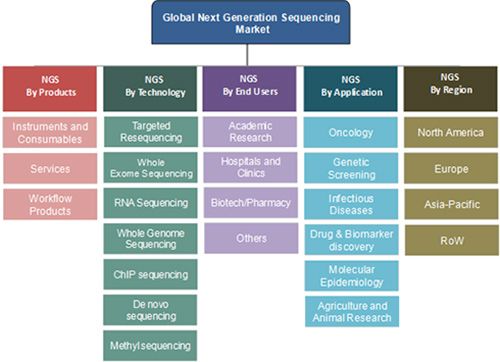Hemamalini Kulasekaran Analyst IQ4I Research & Consultancy
NGS has had a big impact on basic research, now the revolutionary technology is changing clinical practices.
Sequencing technology has come a long way. Next-generation sequencing (NGS) has revolutionized the way the human genomes are sequenced. According to experts, in the coming years a human genome will be sequenced at a cost of $1,000 in one to two days. The time and cost required for sequencing has been reduced tremendously since the first human genome was sequenced, which took a decade and around $3 billion. The advancement of NGS technology has recently opened new windows for clinical diagnosis.
IQ4I Research & Consultancy analysis indicates that the global next-generation sequencing market is expected to reach $4,892 million by 2020 at a CAGR of 20.7%. IQ41’s report provides market revenue and key volume analysis of NGS sample runs performed by various technologies, platforms, and end users/laboratories.
The reduced cost and high speed of NGS technology has increased its use in the clinical segment, that fact as well as the growth of personalized medicine, increased medical spending, and switch over from microarrays to NGS are driving the NGS market growth. However, the outlook isn’t entirely rosy, problem areas include standardization and accuracy of NGS procedures, complexity in data interpretation and storage, shortage of skilled labor, and dependence on grants and funding for NGS infrastructure.
Instruments and consumables are the largest segment among the global NGS market, accounting for almost half of the market in 2013. The fastest growing segment is services with a CAGR of more than 20%.
The global NGS market is segmented into targeted resequencing, whole exome sequencing, RNA sequencing, whole-genome sequencing, ChIP sequencing, de novo sequencing, and methyl sequencing. Among these, targeted re-sequencing accounted for the largest share in 2013. The fastest growing technology is whole-genome sequencing, which has a CAGR of more than 25%. Targeted resequencing and whole-genome sequencing technologies have great promise as various targeted disease-based NGS assays and panels are emerging.
According to the IQ4I report, academic researchers are the predominant NGS end users; the segment has a market share of around 60% (revenue and volume). Hospitals and clinics are forecast to grow at a high CAGR to account for more than 40% in 2020. The rising demand and the increasing application in the clinical segment is expected to drive the market at the highest CAGR during the forecast period for a share of around 25% by 2020.
By application type, the market is broken down into oncology, genetic screening, infectious diseases, drug and biomarker discovery, molecular epidemiology, agriculture, and other applications. Among the overall applications, oncology holds the largest share in terms of revenue and sample volume market, accounting for more than 35% of the market.
North America holds the largest share of the global NGS market, accounting for $571 million in 2013. Asia-Pacific is the fastest growing region with the highest CAGR during the forecast period. The major players operating in the NGS market are Illumina, Thermo Fisher, Hoffmann-La Roche, Pacific Biosciences, Agilent Technologies, BGI, Qiagen, Biomatters, and Genomatix Software. Illumina is the leader in the NGS market followed by Thermo Fisher Scientific and Hoffmann-La Roche and these companies together hold more than 90% of the market share.
Hemamalini Kulasekaran is an analyst at IQ4I Research & Consultancy. Contact [email protected] for more information.







